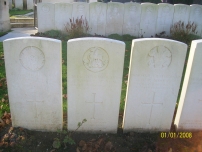| First Name: | Alfred William | Last Name: | DOUGLAS | |
|---|---|---|---|---|
| Date of Death: | 03/09/1916 | Lived/Born In: | Queen's Park | |
| Rank: | Second Lieutenant | Unit: | Warwickshire14 | |
| Memorial Site: | ||||
Current Information:Age-21 29, Fifth Avenue, Queen's Park Corbie Communal Cemetery, Somme
The Battle of the Somme (July-November, 1916) By the beginning of September, 1916, the Battle of the Somme had been raging for two months. Thousands of men had already been killed or wounded or were simply missing, never to be seen again and and just a few square miles of the French countryside, all in the southern part of the battlefield, had been captured from the enemy. Mistakes had been made by the various commanders and would be continued to be made but there was no turning back as the British, Australians, South Africans, New Zealanders and Canadians carried on battering away at the German defences in the hope of a breakthrough, So it continued all the way through to November with nearly every battalion and division then in France being drawn into it at some stage. In the end the German trenches had been pushed back a few more miles along most of the line but the cost in lives had been staggering. By the end of the fighting in November, 1916, British Army casualties numbered over 400,000, killed, wounded and missing. The German second line ran through the village of Guillemont in the southern part of the battlefield and all attempts to capture it through July and August, 1916 had failed. The ferocity of the battle there had transformed the area into something aptly described in the History of The Rifle Brigade 1914-1918, by Reginald Berkeley, as “..a horror that can hardly be imagined. Not merely was the front line impossible to be held: it could only be approached by men of the most iron fortitude. The position was dangerously exposed to fire from the village; but that was nothing. What horrified the senses and shocked the imagination was not what might come from outside the trenches, but what was in them. From end to end they were choked with British dead, on their backs, on their faces, hideously doubled up, distorted with pain, blackened and bloated by the sun, the prey of myriad upon myriad of carrion flies, odiously green with corruption…like a descent to the anterooms of Hell”. Between 3rd and 6th September the village of Guillemont was attacked and captured by 5th Division and 20th Division. Guillemont was in British hands by the end of the first day of the battle and by 6th September, further gains to the east of the village had taken the front line to the edge of Leuze Wood. On 3rd September, 2nd Scottish Borderers of 13 Brigade, 5th Division, attacked Falfemont Farm from assembly trenches on the slope of the Leuze Wood spur, some 400 yards away. Unfortunately the French on the right were prevented from moving forward by machine gun fire and the French artillery barrage, intended to cover the advance of 2nd Scottish Borderers, did not happen. Around noon, 14th Warwickshire and 15th Warwickshire, both of 13 Brigade, resumed the attack against Falfemont Farm but were checked by enfilade fire from the slopes of the Combles Ravine, which had not been cleared by the French. On the left, 14th Warwickshire gained an old battery position and a footing in the trench immediately south of Wedge Wood, capturing 17 prisoners and 2 machine-guns. However, the barrage supporting this attack had been poor with the creeping barrage actually coming down behind 14th Warwickshire. Alfred Douglas died of wounds on this day and may have been wounded on a previous occasion. |
||||
Other Photos: |
||||
| « Back to Search Results | ||||
| If you think any of the information shown here is incorrect, Click Here to submit your amends and comments | ||||





